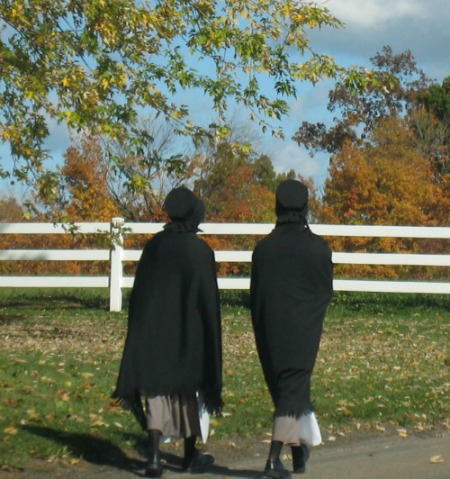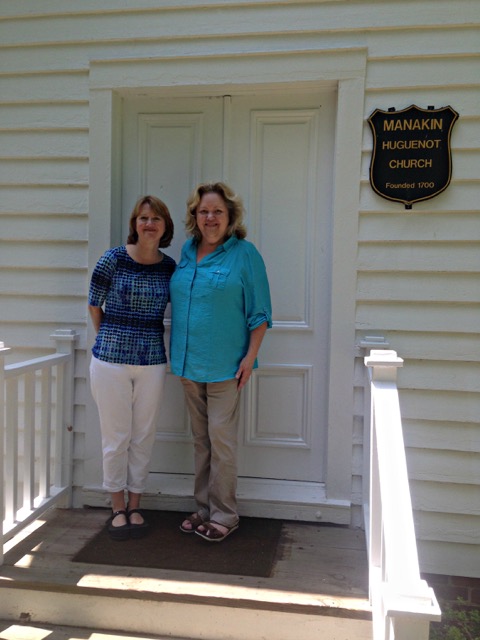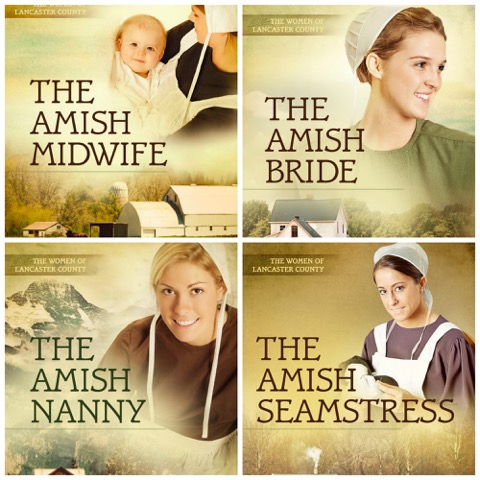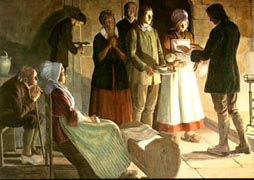Of Kapps and Carriages: A Comparison Between the Amish and the Huguenots (Plus a Giveaway!)
Article by Leslie Gould
During my research for The Women of Lancaster County series, which I co-wrote with Mindy Starns Clark, my fascination with church history expanded exponentially. For a while I was “living” in 16th century Switzerland, the time and place where the Anabaptists—the foundational movement of both the Mennonites and Amish—originated. The more I learned about the era, the more fascinated I became with the Reformation and the many branches of Protestantism it produced.
When a reader told me about her Huguenot (French Calvinists) ancestors who immigrated to America about the same time as the first Amish came to Pennsylvania, I was immediately intrigued.
 My research into this group of early Protestants resulted in another series with Mindy—Cousins of the Dove, a modern/historical saga that traces a fictional French Huguenot Family from the 1600s to the modern day. The first novel in the series, My Brother’s Crown, released in October, and we’re currently writing the second, My Sister’s Prayer.
My research into this group of early Protestants resulted in another series with Mindy—Cousins of the Dove, a modern/historical saga that traces a fictional French Huguenot Family from the 1600s to the modern day. The first novel in the series, My Brother’s Crown, released in October, and we’re currently writing the second, My Sister’s Prayer.
As I continue to immerse myself in Huguenot history, I can’t help but compare and contrast the Huguenots to the Amish. Following is a very brief and very simple introduction to what Mindy and I have learned through the years. To see how we were able to weave this knowledge into compelling fiction featuring brave heroines who face nearly insurmountable odds, you’ll have to read the books!
* * *
1. Origins
Verdict: very similar
Both the Anabaptists and the Huguenots originated in the early 16th Century as a result of the Protestant Reformation. The Anabaptists had their start in 1525 and the Huguenots in 1530.
2. Formative Years
Verdict: somewhat similar
The Anabaptists began in Switzerland and then spread, largely due to persecution, throughout Europe and eventually to both Russia and America. They were often referred to as being part of the “Radical Reformation.”
The Mennonites were Anabaptists who followed the teachings of Menno Simons. The Amish broke off from the Mennonites in 1693, believing the original group was drifting away from the teachings of Simons, and were led by Jakob Ammann.
John Calvin, the founder of Calvinism, was French but ended up fleeing to Switzerland and eventually pastoring a church there. However, his teachings led to the establishment of many churches in France too, and by 1562 there were two million French Calvinists—or Huguenots, as they were soon called. Like the Amish, most were eventually forced from their homeland. During the 1680s alone, an estimated 400,000 Huguenots fled France due to persecution under Louis XIV, going as far away as South Africa and North America. (There was a small group of Huguenots who stayed in France, and they will be explored in the fourth novel in our series.)
3. Baptism
Verdict: very different
A belief in adult baptism was one of the reasons the Anabaptists broke off from the Swiss Reformed Church. The Anabaptists believed only adults could make the decision to be baptized and quit baptizing their infants, which led to persecution by the Reformed Church, the Swiss government, and the Catholic Church.
On the other hand, Calvinists retained the tradition of infant baptism, believing it to be a covenant with God. (There are, of course, other theological differences between the two groups, including predestination. A primary source on the subject is John Calvin’s Treatises Against the Anabaptists and Against the Libertines. There are also, however, many basic similarities in the theology of the two groups.)
4. Simplicity
Verdict: different
Throughout their history the Amish have been known for their simple living. They, generally, reject modern ways, choosing to drive horses and buggies and to live off the grid. From the beginning, the Amish dressed simply and even referred to themselves as “Plain.” Today, the women still wear Kapps, modest dresses, and aprons, while the men wear suspenders and wide-brim hats. Traditionally, the Amish worked as farmers. Today, as the population grows, they’re running out of land and more are opening businesses or working in factories or other manufacturing jobs. Most Amish communities continue to meet on one another’s properties instead of in a church building, just as they’ve done since the beginning.
The Huguenots included members of the French wealthy class and even the gentry. Many had large homes, fine carriages, and a significant amount of material goods. (Although there were certainly poor Huguenots too—more so in rural areas.) Congregations usually built churches (called temples) where they worshipped together. Although their dress may have been more modest than the latest fashions, they did not focus on a simple lifestyle as part of their overall philosophy.
 5. Today
5. Today
Verdict: very different
Within a couple of generations the Huguenots assimilated into the dominant cultures that they joined—but they also left a lasting influence on those societies. Eight of our U.S. presidents had proven Huguenot ancestors, including George Washington, whose great-great-great-grandfather arrived in Virginia in 1620. Twelve other U.S. Presidents had credible claims to Huguenot ancestors. The experiences of the French Huguenots also seem to have contributed to the inclusion of Freedom of Religion in the First Amendment of our Constitution. Today there are Huguenot societies around the world, including one in Virginia that Mindy and I visited, that continue to preserve and share the history of their ancestors.
On the other hand, the Anabaptists have assimilated to a lesser degree. There are a total of 2.1 million Anabaptists worldwide, including Mennonites, Mennonite Brethren, Hutterites, and Amish. The Amish, as we know, are one of the groups who have assimilated the least. Today, there are nearly 300,000 Amish in the United States, up from 5,000 in 1924 and 84,000 in 1984. They are one of the fastest growing groups in the United States thanks to a birthrate that is three to four times higher than the U.S. average. (There are also Amish settlements in Canada and a Beachy Amish Mennonite Fellowship in Ireland.)
* * *
 Thank you for stopping by today! I hope you’ve enjoyed this quick comparison.
Thank you for stopping by today! I hope you’ve enjoyed this quick comparison.
Please leave a comment below to enter for a chance to win a set of The Women of Lancaster County series OR a copy of My Brother’s Crown.
Fine print: Giveaway is open internationally and lasts through November 24, 2015. Participants must be 18 years old or older to enter. Two winners will be randomly selected—one for The Women of Lancaster County series (four-book set) and one for My Brother’s Crown. These winners will be contacted via email on Wednesday, November 25. The prizes will be provided by the author, and the giveaway is in no way sponsored by or affiliated with Facebook, WordPress, Pinterest, or Twitter.
* * *
Leslie Gould is a bestselling author of 20 novels. She received her master of fine arts degree from Portland State University and lives in Oregon with her husband, Peter, and their four children. Connect with Leslie at www.lesliegould.com.















 3. A day working in the garden or a day running a produce stand?
3. A day working in the garden or a day running a produce stand?





